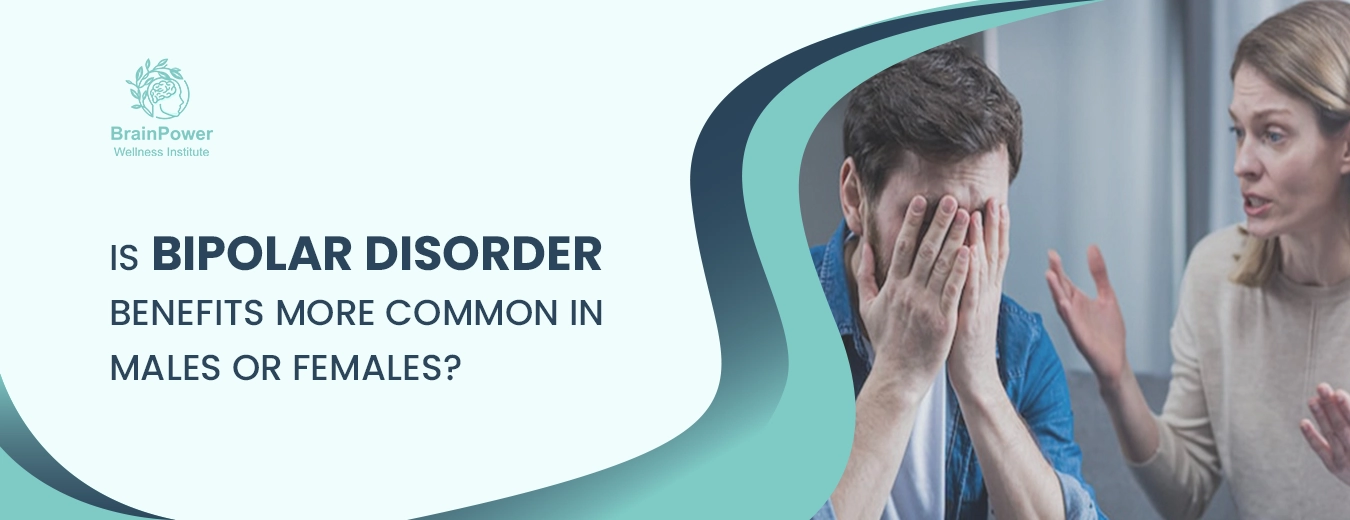According to information from the World Health Organization (WHO), bipolar disorder affects around 140 million people worldwide and is among the top 10 causes of disability in young adults. Another fact that draws attention is that suicide rates in patients with bipolar disorder are 7.8% in men and 4.9% in women. In this blog, we’ll discuss is bipolar disorder more common in males or females, so keep reading.
What Is Bipolar Disorder?
Bipolar disorder, which affects 4.4% of the population involves changes in mood that are more noticeable, lasting, and, often, more harmful than isolated moments of normal sadness or joy in everyday life.
Bipolarity is also characterized by episodes of depression and mania that, in general, begin in adolescence or early adulthood. During a manic episode, the individual experiences inflated self-esteem, reduced sleep, and agitation.
In addition, the person may become more talkative than usual and have difficulty maintaining focus on activities. The hypomanic episode has similar symptoms; however, it is less severe and shorter.
A depressive episode is characterized by a depressed mood for most of the day, loss of interest in daily activities, weight loss or gain, insomnia or increased amount of sleep, excessive guilt, and suicidal ideation, among others.
Impacts on Women
Although bipolar disorder is common in both men and women, research published in the Journal of Clinical Psychiatry showed that about three times as many women as men go through a rapid cycle of the disorder.

Bipolar Disorder Symptoms in Women
Female audiences may have more depressive episodes and mixed episodes. Bipolar woman is more likely to develop episodes of both depression and mania during pregnancy and the postpartum period. In these cases, postpartum depression may be associated with psychotic symptoms.
Accurate detection of bipolar disorder can help to establish adequate treatment for depression (or mania), capable of reducing the risk of suicide and infanticide.
Impacts on Men
Bipolar disorder is an equal-opportunity condition, affecting both men and women. However, exploring how it uniquely impacts men sheds light on the nuances of their mental health journey.
Read More: What Practices and Habits Can Help Alleviate the Symptoms of Bipolar Disorder?
Signs of Bipolar Disorder in Men:
Men with bipolar disorder may experience distinct manifestations. Research suggests that initial manic episodes are more prevalent in males, marked by heightened energy, impulsivity, and risk-taking behaviors.
Risk Factors of Bipolar Disorder in Men
Certain risk factors may amplify the impact of bipolar disorder in men. Substance abuse, a common co-occurring issue, can exacerbate mood swings, complicating the management of the condition.
8 Ways Bipolar Disorder Affects Men and Women Differently
Bipolar disorder, a condition characterized by extreme mood swings, manifests uniquely in men and women. Understanding these gender-specific differences is pivotal for effective diagnosis and tailored interventions.
Mood Fluctuations: A Gendered Difference
- Men: Often experience more manic episodes characterized by elevated energy and impulsivity.
- Women: Prone to rapid cycling, transitioning swiftly between manic and depressive states.
Onset Age: A Varied Chronology
- Men: Symptoms may manifest in the late teens or early 20s.
- Women: Tend to experience onset later, often in their 20s or 30s.
Comorbidity Challenges
- Men: More likely to have comorbid substance abuse issues.
- Women: May grapple with additional comorbidities such as thyroid or mood disorders or migraines.
Hormonal Influences: A Female Dilemma
- Women: Hormonal fluctuations during menstruation, pregnancy, and menopause can trigger mood swings.
- Men: Experience hormonal stability, contributing to a more consistent mood pattern.
Treatment Response: Tailoring Approaches
- Men: May respond better to lithium, a common mood stabilizer.
- Women: May benefit from mood stabilizers and adjunct therapies to address hormonal influences.
Coping Mechanisms: Gendered Strategies
- Bipolar symptoms in men: Tend to externalize symptoms, displaying irritability and aggression.
- Bipolar disorder symptoms in females: May internalize, exhibiting symptoms like fatigue and worthlessness.
Social Impact: Stigma and Perception
- Men: Face societal expectations of emotional restraint, leading to potential underreporting.
- Women: Confront stereotypes related to mood swings, often resulting in misinterpretation.
Suicide Risk: A Gendered Concern
- Men: Higher risk due to impulsivity during manic phases.
- Women: Elevated risk during depressive phases, often linked to comorbidities.
Gender Disparities in Bipolar Subtypes
Understanding these nuanced distinctions empowers healthcare professionals to adopt gender-sensitive approaches, ensuring more effective management and improved quality of life for individuals navigating bipolarity.
Bipolar I Disorder: A Gendered Prelude
- Men: Marginally more prone to experiencing manic episodes characteristic of Bipolar I.
- Women: Exhibit a higher likelihood of rapid cycling between manic and depressive states.
Bipolar II Disorder: Unraveling Gender Variances
- Men: May present with more pronounced depressive episodes in Bipolar II.
- Women: Show a proclivity towards rapid cycling and mixed episodes.
Cyclothymic Disorder: A Gendered Symphony
- Men: Cyclothymic patterns tend to manifest with shorter, intense cycles.
- Women: May experience more prolonged and unpredictable mood fluctuations.
Prevalence Across the Gender Spectrum
- Men: Generally, exhibit a higher prevalence of Bipolar I disorder.
- Women: Display a higher prevalence of Bipolar II disorder and rapid cycling.
Hormonal Influences: Impact on Bipolar Dynamics
- Men: Hormonal stability contributes to the consistency of mood patterns.
- Women: Hormonal fluctuations during menstruation, pregnancy, and menopause can influence the severity and frequency of mood episodes.
Comorbidity Complexities
- Men: Substance abuse issues may often accompany Bipolar I.
- Women: Higher likelihood of comorbidities such as anxiety disorders and thyroid dysregulation.

Bipolar Disorder: A Call to Awareness for Every Gender
Bipolar disorder affects individuals of every gender. Now, let’s discuss why all genders should take the matter seriously, breaking down stereotypes and emphasizing the importance of a collective effort in addressing bipolar disorder.
Breaking Gender Stereotypes in Mental Health
In a society where gender norms often dictate mental health discussions, it is crucial to break free from stereotypes. Bipolar disorder affects individuals regardless of gender, emphasizing the need for an inclusive conversation surrounding mental health.
Recognizing the Universal Impact Of Bipolar Disorder
Bipolar disorder manifests in various ways, with symptoms that transcend gender boundaries. From intense mood swings to disrupted sleep patterns, recognizing these signs is essential for everyone, irrespective of gender identity.
Read More: Is Bipolar Disorder More Common in Males or Females?
Mood Swings Affect All Genders
- Men: Break the stereotype of emotional stoicism; acknowledge the validity of mood fluctuations.
- Women: Move beyond societal expectations; embrace open discussions about mental health challenges.
Tailoring Treatment Approaches for Every Gender
Understanding the diversity of gender experiences is vital in tailoring effective treatment plans. By recognizing and respecting individual gender identities, mental health professionals can provide more personalized care, fostering better outcomes for those with bipolar disorder.
Fostering Cross-Gender Support Networks
Combatting the stigma associated with bipolar disorder requires a united front. This section emphasizes the importance of creating a supportive community that spans genders, fostering understanding and solidarity in the face of mental health challenges.
Conclusion
In wrapping up our exploration into the topic is bipolar more common in males or females, it’s evident that this mental health challenge doesn’t conform to gender norms. The question of whether it’s more common in one gender than the other lacks a straightforward answer. Bipolar disorder affects individuals across the gender spectrum, highlighting the need for a nuanced and inclusive understanding.
As we strive to break down the walls of stigma surrounding mental health, it’s crucial to recognize that seeking help is a brave and essential step. If you or someone you know is grappling with bipolar disorder, remember that support is available, and reaching out is a sign of strength.
For tailored support, consider BrainPower Wellness Institute. They understand the complexities of mental health, offering personalized care. Take a step toward balance—connect with BrainPower today. Your well-being matters, and they’re here to guide you to a healthier life.




